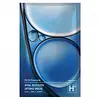What's inside
What's inside
 Key Ingredients
Key Ingredients

 Benefits
Benefits

 Concerns
Concerns

 Ingredients Side-by-side
Ingredients Side-by-side

Water
Skin ConditioningGlycerin
HumectantDipropylene Glycol
HumectantAlcohol
AntimicrobialPEG/PPG-17/6 Copolymer
SolventButylene Glycol
Humectant1,2-Hexanediol
Skin ConditioningPaeonia Suffruticosa Root Extract
Skin ProtectingCentella Asiatica Extract
CleansingAmmonium Acryloyldimethyltaurate/Vp Copolymer
Trehalose
HumectantPanthenol
Skin ConditioningPEG-60 Hydrogenated Castor Oil
EmulsifyingChamomilla Recutita Flower Extract
MaskingGlyceryl Caprylate
EmollientCarbomer
Emulsion StabilisingAdenosine
Skin ConditioningEthylhexylglycerin
Skin ConditioningPotassium Hydroxide
BufferingSodium Hyaluronate
HumectantHydroxypropyltrimonium Hyaluronate
Propanediol
SolventHydrolyzed Collagen
EmollientSodium Hyaluronate Crosspolymer
HumectantHydrolyzed Glycosaminoglycans
HumectantBenzyl Glycol
SolventHydrolyzed Hyaluronic Acid
HumectantSodium Acetylated Hyaluronate
HumectantHyaluronic Acid
HumectantRaspberry Ketone
MaskingDisodium EDTA
Parfum
MaskingLinalool
PerfumingWater, Glycerin, Dipropylene Glycol, Alcohol, PEG/PPG-17/6 Copolymer, Butylene Glycol, 1,2-Hexanediol, Paeonia Suffruticosa Root Extract, Centella Asiatica Extract, Ammonium Acryloyldimethyltaurate/Vp Copolymer, Trehalose, Panthenol, PEG-60 Hydrogenated Castor Oil, Chamomilla Recutita Flower Extract, Glyceryl Caprylate, Carbomer, Adenosine, Ethylhexylglycerin, Potassium Hydroxide, Sodium Hyaluronate, Hydroxypropyltrimonium Hyaluronate, Propanediol, Hydrolyzed Collagen, Sodium Hyaluronate Crosspolymer, Hydrolyzed Glycosaminoglycans, Benzyl Glycol, Hydrolyzed Hyaluronic Acid, Sodium Acetylated Hyaluronate, Hyaluronic Acid, Raspberry Ketone, Disodium EDTA, Parfum, Linalool
Water
Skin ConditioningDipropylene Glycol
HumectantNiacinamide
SmoothingPEG/PPG-17/6 Copolymer
SolventBis-PEG-18 Methyl Ether Dimethyl Silane
EmollientButylene Glycol
HumectantPEG-60 Hydrogenated Castor Oil
EmulsifyingPaeonia Suffruticosa Root Extract
Skin ProtectingCentella Asiatica Extract
CleansingCarbomer
Emulsion Stabilising1,2-Hexanediol
Skin ConditioningAmmonium Acryloyldimethyltaurate/Vp Copolymer
Dimethicone
EmollientChamomilla Recutita Flower Extract
MaskingGlyceryl Caprylate
EmollientPropolis Extract
Skin ConditioningPotassium Hydroxide
BufferingCellulose Gum
Emulsion StabilisingAdenosine
Skin ConditioningEthylhexylglycerin
Skin ConditioningSodium Polyacrylate
AbsorbentHippophae Rhamnoides Fruit Extract
Skin ConditioningDextrin
AbsorbentGardenia Florida Fruit Extract
Skin ConditioningRoyal Jelly Extract
Skin ConditioningTheobroma Cacao Extract
Skin ConditioningMagnesium Ascorbyl Phosphate
AntioxidantBHT
AntioxidantAnthemis Nobilis Flower Extract
MaskingOenothera Biennis Flower Extract
AstringentCalendula Officinalis Flower Extract
MaskingDisodium EDTA
Parfum
MaskingWater, Dipropylene Glycol, Niacinamide, PEG/PPG-17/6 Copolymer, Bis-PEG-18 Methyl Ether Dimethyl Silane, Butylene Glycol, PEG-60 Hydrogenated Castor Oil, Paeonia Suffruticosa Root Extract, Centella Asiatica Extract, Carbomer, 1,2-Hexanediol, Ammonium Acryloyldimethyltaurate/Vp Copolymer, Dimethicone, Chamomilla Recutita Flower Extract, Glyceryl Caprylate, Propolis Extract, Potassium Hydroxide, Cellulose Gum, Adenosine, Ethylhexylglycerin, Sodium Polyacrylate, Hippophae Rhamnoides Fruit Extract, Dextrin, Gardenia Florida Fruit Extract, Royal Jelly Extract, Theobroma Cacao Extract, Magnesium Ascorbyl Phosphate, BHT, Anthemis Nobilis Flower Extract, Oenothera Biennis Flower Extract, Calendula Officinalis Flower Extract, Disodium EDTA, Parfum
 Reviews
Reviews

Ingredients Explained
These ingredients are found in both products.
Ingredients higher up in an ingredient list are typically present in a larger amount.
1,2-Hexanediol is a synthetic liquid and another multi-functional powerhouse.
It is a:
- Humectant, drawing moisture into the skin
- Emollient, helping to soften skin
- Solvent, dispersing and stabilizing formulas
- Preservative booster, enhancing the antimicrobial activity of other preservatives
Adenosine is in every living organism. It is one of four components in nucleic acids that helps store our DNA.
Adenosine has many benefits when used. These benefits include hydrating the skin, smoothing skin, and reducing wrinkles. Once applied, adenosine increases collagen production. It also helps with improving firmness and tissue repair.
Studies have found adenosine may also help with wound healing.
In skincare products, Adenosine is usually derived from yeast.
Learn more about AdenosineAmmonium Acryloyldimethyltaurate/Vp Copolymer (let's call it AAVC for short) is a synthetically created polymer. It's used as a film-forming agent and used to thicken the consistency of products.
AAVC is able to increase the consistency and viscosity of products due to its large molecule size. It also prevents ingredients from separating.
Butylene Glycol (or BG) is used within cosmetic products for a few different reasons:
Overall, Butylene Glycol is a safe and well-rounded ingredient that works well with other ingredients.
Though this ingredient works well with most skin types, some people with sensitive skin may experience a reaction such as allergic rashes, closed comedones, or itchiness.
Learn more about Butylene GlycolCarbomer is a polymer of acrylic acid. Its main role is to create a gel consistency.
A high amount of carbomer can cause pilling or balling up of products. Don't worry, most products contain 1% or less of carbomer.
Centella Asiatica Extract (Centella) is derived from an herb native to Southeast Asia. It is famous for its anti-inflammatory and soothing properties.
Centella is rich in antioxidants and amino acids, such as Madecassic Acid and Asiaticoside.
Studies show the compounds in centella help with:
The combination of all these properties makes centella effective at soothing, hydrating, and protecting the skin.
Other great components of centella include Vitamin A, vitamin C, several B vitamins, and Asiatic Acid.
Fun fact: Centella has been used as a medicine and in food for many centuries. As a medicine, it is used to treat burns, scratches, and wounds.
Learn more about Centella Asiatica ExtractChamomilla Recutita Flower Extract comes from the Chamomile flower.
Chamomile is rich in antioxidants and has anti-inflammatory properties. Several compounds found in chamomile help with soothing, such as bisbolol.
Antioxidant components in chamomile make it an effective ingredient to help slow the signs of aging. Antioxidants help fight free-radical molecules, or molecules that may damage your skin.
Essential oils from chamomile have been found to improve wound healing due to its antimicrobial properties.
Ancient Greeks and Egyptians used Chamomile to treat skin redness and dryness. Chamomile has also been used to help treat stomach issues.
Learn more about Chamomilla Recutita Flower ExtractDipropylene Glycol is a synthetically created humectant, stabilizer, and solvent.
This ingredient helps:
Dipropylene glycol is technically an alcohol, but it belongs to the glycol family (often considered part of the ‘good’ alcohols). This means it is hydrating and gentle on skin unlike drying solvent alcohols like denatured alcohol.
As a masking agent, Dipropylene Glycol can be used to cover the smell of other ingredients. However, it does not have a scent.
Studies show Dipropylene Glycol is considered safe to use in skincare.
Learn more about Dipropylene GlycolDisodium EDTA plays a role in making products more stable by aiding other preservatives.
It is a chelating agent, meaning it neutralizes metal ions that may be found in a product.
Disodium EDTA is a salt of edetic acid and is found to be safe in cosmetic ingredients.
Learn more about Disodium EDTAEthylhexylglycerin (we can't pronounce this either) is commonly used as a preservative and skin softener. It is derived from glyceryl.
You might see Ethylhexylglycerin often paired with other preservatives such as phenoxyethanol. Ethylhexylglycerin has been found to increase the effectiveness of these other preservatives.
Glyceryl Caprylate comes from glycerin and caprylic acid, a fatty acid from coconut. It has emollient and emulsifier properties.
As an emollient, it helps hydrate your skin. Emollients work by creating a barrier on your skin to trap moisture in, helping to keep your skin soft and smooth.
On the other hand, emulsifiers prevent ingredients (such as oil and water) from separating.
Learn more about Glyceryl CaprylatePaeonia Suffruticosa Root Extract comes Peony plant. It has anti-inflammatory and antioxidant properties.
Emerging studies also show peony root may help reduce hyperpigmentation.
Ancient Chinese medicine has used peony root to treat dark spots, but studies are looking into this claim more.
Learn more about Paeonia Suffruticosa Root ExtractParfum is a catch-all term for an ingredient or more that is used to give a scent to products.
Also called "fragrance", this ingredient can be a blend of hundreds of chemicals or plant oils. This means every product with "fragrance" or "parfum" in the ingredients list is a different mixture.
For instance, Habanolide is a proprietary trade name for a specific aroma chemical. When used as a fragrance ingredient in cosmetics, most aroma chemicals fall under the broad labeling category of “FRAGRANCE” or “PARFUM” according to EU and US regulations.
The term 'parfum' or 'fragrance' is not regulated in many countries. In many cases, it is up to the brand to define this term.
For instance, many brands choose to label themselves as "fragrance-free" because they are not using synthetic fragrances. However, their products may still contain ingredients such as essential oils that are considered a fragrance by INCI standards.
One example is Calendula flower extract. Calendula is an essential oil that still imparts a scent or 'fragrance'.
Depending on the blend, the ingredients in the mixture can cause allergies and sensitivities on the skin. Some ingredients that are known EU allergens include linalool and citronellol.
Parfum can also be used to mask or cover an unpleasant scent.
The bottom line is: not all fragrances/parfum/ingredients are created equally. If you are worried about fragrances, we recommend taking a closer look at an ingredient. And of course, we always recommend speaking with a professional.
Learn more about ParfumPeg-60 Hydrogenated Castor Oil comes from hydrogenated castor oil. It is a solubilizer and emulsifier.
As a solubilizer, it helps dissolve ingredients into a water-based version. It is also an emulsifer. Emulsifier help prevent oils and water from separating. Both these properties help create evenly-spread and uniform products.
Basically, Peg-60 Hydrogenated Castor Oil helps hold ingredients together.
Learn more about PEG-60 Hydrogenated Castor OilWe don't have a description for PEG/PPG-17/6 Copolymer yet.
Potassium hydroxide is commonly known as caustic potash. It is used to fix the pH of a product or as a cleaning agent in soap. In cleansers, it is used for the saponification of oils.
Sapnification is the process of creating fatty acid metal salts from triglycerides and a strong base. During this process, Potassium Hydroxide is used up and is not present in the final product.
Using high concentrations of Potassium Hydroxide have shown to irritate the skin.
Learn more about Potassium HydroxideWater. It's the most common cosmetic ingredient of all. You'll usually see it at the top of ingredient lists, meaning that it makes up the largest part of the product.
So why is it so popular? Water most often acts as a solvent - this means that it helps dissolve other ingredients into the formulation.
You'll also recognize water as that liquid we all need to stay alive. If you see this, drink a glass of water. Stay hydrated!
Learn more about Water